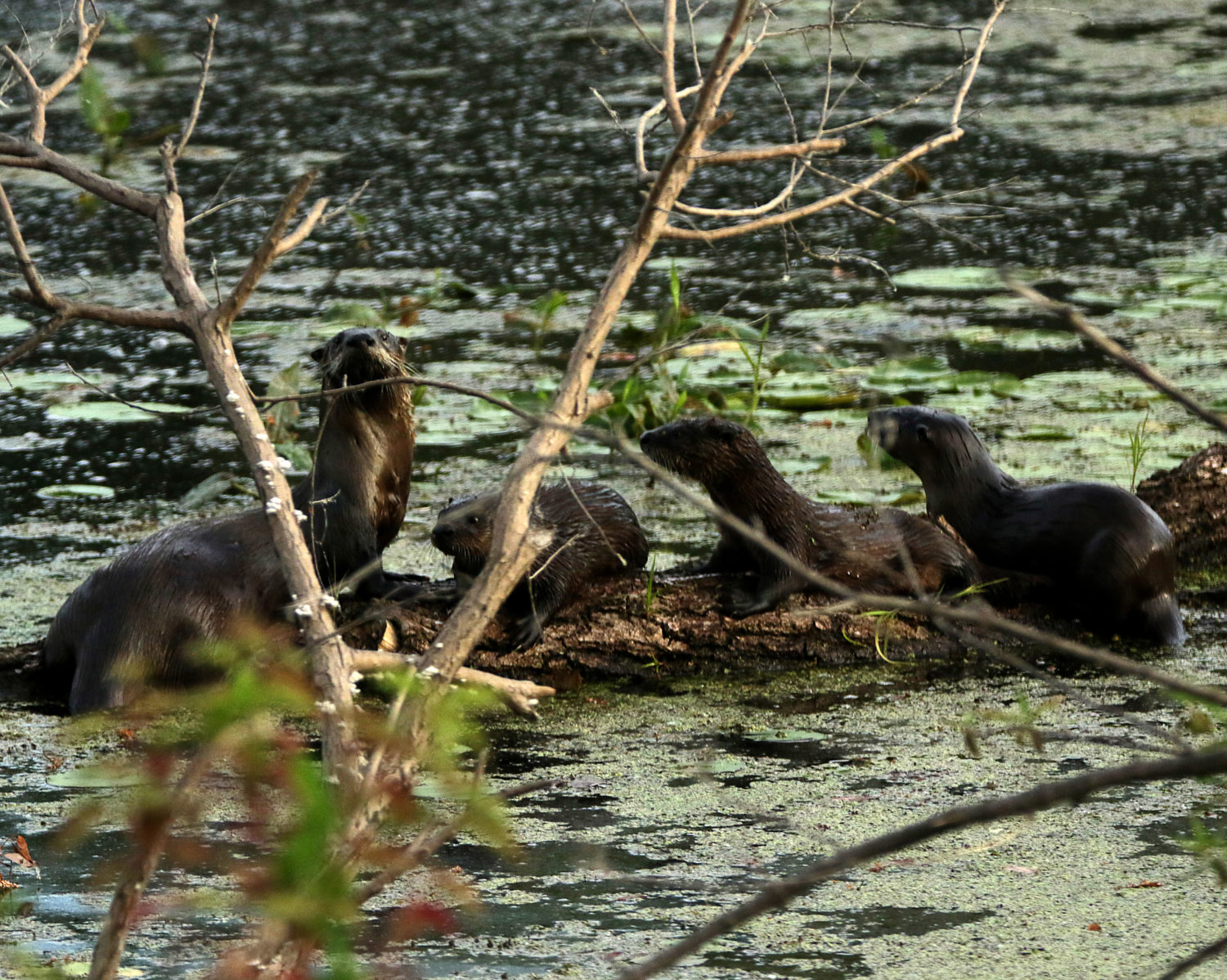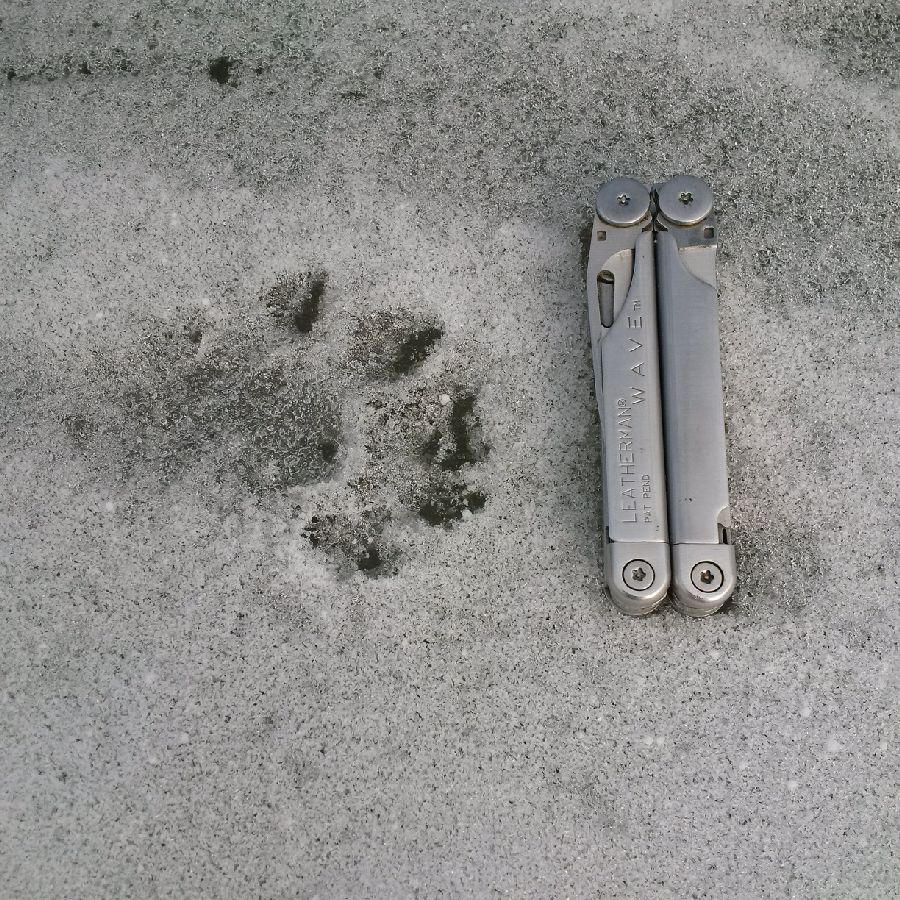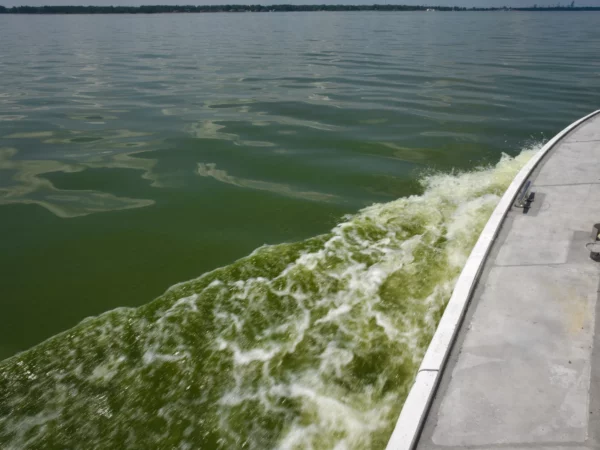
Great Lakes Moment is a monthly column written by Great Lakes Now Contributor John Hartig. Publishing the author’s views and assertions does not represent endorsement by Great Lakes Now or Detroit Public Television.
Most people know river otters from zoos or YouTube videos as endearing playful creatures that can put a smile on anyone’s face.
The river otter, once common throughout much of North America, was first reduced by trapping and then displaced from many areas by loss of habitat from urbanization and pollution. But sightings along western Lake Erie at Ottawa National Wildlife Refuge in Ohio and Point Pelee National Park in Leamington, Ontario, and evidence of a return of river otter to Toronto Harbour, raise the prospects that they just might return one day to the Detroit River too.
The river otter makes its home near the water. They live in a den by the edge of a lake, stream, or marsh. One fun fact is that River Otters don’t dig their own dens, they either use a natural hollow or burrow made by another animal. Otter dens feature numerous tunnels with easy access to water, especially for night hunting for fish, amphibians, crayfish and other aquatic delicacies. They can even close their nostrils to keep water out during long dives and stay underwater for up to 8 minutes.
Check out the Detroit Zoo’s live otter cam HERE.

Trail cam photo of a river otter from the Toronto and region watershed. (Photo credit: Toronto Region Conservation Authority).
Historically, river otters were present throughout most of North America, including southeast Michigan and southwest Ontario. One Monroe County, Michigan, creek is even named Otter Creek, a testament to how common they were during the late 1700s. However, that all changed during the Fur Trade Era when river otters were harvested in large numbers for their valuable water-resistant pelts. While hunting and trapping reduced otter numbers in Michigan, Ontario and Ohio, urbanization and water pollution proved to be the final blows. By the early 1900s these semi-aquatic mammals were gone.
In 1986, the Ohio Department of Natural Resources began a 7-year project to reintroduce river otters to areas with clean water and abundant food supply. More than 100 River Otters were captured in Arkansas and Louisiana, where they were still common, and transported to eastern Ohio. They were then released in the Grand River (a tributary of the central basin of Lake Erie) and Killbuck Creek, Little Muskingum River and Stillwater Creek, which flow into rivers that are part of the Mississippi River watershed.
By all accounts the river otter has not only survived but thrived in these watersheds. Monitoring has shown slow but steady growth of the population, and in 2002 it was even removed from Ohio’s list of state endangered species. But as the river otter population grew, individual otters began to adventure out to new watersheds – what scientists call expanding their range.
Some of the adventurous otters have now found a home in western Ohio. River otter sightings have occurred annually for more than 10 years from Cedar Point south to Darby, Ohio, near Columbus. Along the southern shore of western Lake Erie, not only have they been seen in Cedar Point, but Ottawa National Wildlife Refuge located just 15 miles east of Toledo, Magee Marsh Wildlife Area and the Toussaint River. Ottawa National Wildlife Refuge manages 6,500 acres of wetlands, grasslands and woodlands for protection of a wide diversity of waterfowl and other migratory birds, resident wildlife, and threatened and endangered species. Refuge biologists and volunteers have confirmed that they are now reproducing in refuge. What a thrill for conservationists and nature lovers to see them frolicking in the waters of western Lake Erie after an 80-year absence.
In March 2019, a naturalist discovered a set of tracks in the snow at Point Pelee National Park in Leamington, Ontario, on the northern shore of western Lake Erie. The tracks were discovered near the DeLaurier Canal and immediately they knew that they were not the mink tracks often seen in the park. There was a set of mink tracks nearby for comparison, which were much smaller, narrower and of course did not have the “slide” marks characteristic of otters.

Suspected river otter tracks at DeLaurier Canal, 2019. (Photo courtesy of Point Pelee National Park.)
Then in June 2019, two Parks Canada team members were in a boat entering the channel to West Cranberry Pond in the park marsh when an otter swam very close to their boat before diving underneath. Within a couple of weeks of that sighting, another team member working at the marsh boardwalk saw an otter swimming in the open water just to the left of the marsh tower. You can imagine how exciting it would be for a naturalist to see the return of river otters to this revered national park for the first time since it was established in 1918.
Situated on the northern shore of Lake Ontario is Toronto – Canada’s largest city and a key hub of the nation’s commercial, financial, industrial and cultural life. It has long been recognized as a pollution hotspot. In 1985 the International Joint Commission identified Toronto and region as a Great Lakes pollution hotspot and area of concern. Since then, substantial cleanup of pollution and habitat restoration have occurred, resulting in a surprising ecological revival.
More than $80 million alone have been invested in habitat restoration in Toronto and region since 1987. One exciting wetland restoration project has been Corner Marsh at Duffins Creek. For decades it had been in a degraded state, and over 10 years ago it was restored to the point where wetland vegetation, nesting birds and amphibians were flourishing again. Corner Marsh now has the highest population density of muskrats on the north shore of Lake Ontario, which attracted river otters to the area. River otters then spread from Duffins Creek and now occupy the entire Toronto waterfront. It has been over a hundred years since river otters freely inhabited the Toronto waterfront.
Knowing that river otters have returned to the once heavily polluted Toronto Harbour, that they have been successfully reintroduced into eastern Ohio, and that they have now been seen along western Lake Erie in Point Pelee National Park, Ottawa National Wildlife Refuge and other locations, is it possible that they just might return one day to the Detroit River?
I say yes.
Skeptics might say no. But we must all remember that as recently as 1985 there were no bald eagles, peregrine falcons, or osprey reproducing in the Detroit River watershed because of eggshell thinning caused by pesticides like DDT, no lake sturgeon or lake whitefish were reproducing in the Detroit River, and beavers had long disappeared.
Today they are all back. Wouldn’t it be wonderful if we had one more ecological surprise?
Keep up with more Great Lakes Moments at Great Lakes Now:
Great Lakes Moment: Earth Day turns 50
Great Lakes Moment: Decline of bird species should serve as a warning
Great Lakes Moment: One man’s foray into high-tech, long-distance birding
Great Lakes Now Contributor John Hartig is a board member at the Detroit Riverfront Conservancy. He serves as the Great Lakes Science-Policy Advisor for the International Association for Great Lakes Research and has written numerous books and publications on the environment and the Great Lakes. Hartig also helped create the Detroit River International Refuge, where he worked as the refuge manager until his retirement.
Featured Image: River otter family at Ottawa National Wildlife Refuge located just east of Toledo, Ohio. (Photo credit: Jeff Vogelpohl)
29 Comments
-
In fading light at a distance of 200 feet, my neighbor and I saw what we thought was a river otter in our marina on East Harbor in Marblehead. I was pretty excited. Turns out next day I saw it again in daylight, relaxing on shore, and it was a beaver. However, been here 13 years and that’s the first beaver I’ve seen on East Harbor. Still cool, though….
-
Agree, still cool. They are in your area so keep your eyes open
-
-
I have a small marina on Middle Bass Island and I swear I saw one in there last weekend!! Could they be on the Lake Erie Islands???
-
Yes they could island hop
-
-
I have seen one in the Huron River of Ohio this year.
-
Really cool! Did you see a den?
-
-
I fear for this return. The otter thrived prior to polllution and the comeback is doubtless a bonus of the Clean Water restriction by both nations.
But Trump’s slashing of the EPA and state funding could have dire consequences.-
Art, Environmental laws are the foundation of environmental protection and conservation efforts. We need to keep them strong and enforce them!
-
-
Last summer my wife and I saw an otter, fish in mouth for dinner at the mouth of Elk Creek in Lake City , Pennsylvania
-
They sure get around.
-
-
I live in Tiny Township part of Simcoe County on the shores of Georgian Bay I have seen a couple of times over the last year an otter swimming just off shore/beach in an area known as Cawaja Beach where I reside
-
They sure are entertaining.
-
-
Just saw what appeared to be a river otter crossing River Road 200 yds east of I-475 in Perrysburg.
-
Saw one in Leamington Ont. behind my house. We have a creek behind which runs into Lake Erie.
-
Please share a picture if you can get one
-
-
Live in Willowick, on Lake Erie. Just had an otter or mink? in the back yard, about 10 feet from me. It was not a squirrel, but was similar size, dark body, furry tail.
-
I saw a young otter on the Detroit River this morning. It was at the area near the old rail line link to the ferry directly across from the Renaissance Centre on the Windsor River front walk. It apprears to be living in the rock areas there.
-
Can you get a picture?
-
-
My husband and I saw one eating a fish on the breaker wall in Maumee Bay StatePark
-
While on our bike ride this morning we saw a large animal cross in front of us..our silver lab was focused only on what just crossed the road…then he came back across in front of us…it was an otter…came home and identified it by looking up otters..it was a very good size..second one we have seen in a year…so awesome..
-
I just saw a dark brown River Otter on twelve Mile Creek in St. Catharines this morning. It crossed the path infront of me to go into the water. No mistaking it!
-
John I saw an otter today in the Detroit river at stony island. This was my 1st spotting. I got some pictures but they are not great
-
Hi John. I was just doing a bit of fishing in the Saugeen River about 1km from the mouth on Lake Huron in Southampton Ont. Saw three of them playing around on a boat jetty. Seemed to be one large one and two slightly smaller. Didn’t have my phone so no pictures. I will keep an eye out and maybe see them again.
-
I was at the Grand River, Hidden Valley park in Lake County,Ohio and spotted a couple holes in the riverbank one had a pile of mussel shells in front of it. Was this an otter den? Also there I saw 28 female common mergansers in the water, a bald eagle flew low over them and they were all splashing frantically to get away! I saw 2 different species of mussels there and saw lots of frogs and crayfish.
-
I saw an otter in Grand Traverse Bay 3 miles south of the tip of Leelanau Peninsula. Two days later a neighbor saw two of them playing in the water. At first I thought it was a mink and after looking up photos online was thrilled to learn it was an otter. Also many years back I saw a pair of otters playing in the Leland river near its outlet into Lake Michigan.
-
That’s cool
-
That’s nice
-
On Saturday I filmed a mammal swimming in Lake Erie at Westfield, NY. At first I thought it was a beaver but when I reviewed the video, it swam more like an otter. It seemed more likely to have an otter in the Great Lakes than a beaver. Is there any definitive way to know?
-
Just saw an otter on Byng Island, near Dunnville, Ontario on Lake Erie. I have lived in southern Ontario most of my life. First time i saw an otter.




